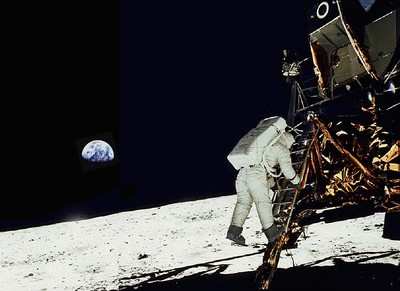Wed, Nov 09, 2011
NASA Wants To Protect Footprints, Among Other Things
It seems incredible to be saying this, but it won't be long
until private citizens are traveling in space, and NASA is
suggesting there should be protections against tourists spoiling
the historic landing sites of the six Apollo missions which went to
the Moon between 1969 and 1972. USA Today reports NASA wants no-fly
zones of 1,200 acres around the landing sites of Apollo 11 and 17,
and no pedestrians allowed within 82 yards of Neil Armstrong's "one
small step for man."

The Google Lunar X-Prize apparently really brought the concern
to the front burner. As many as 30 teams will try to land unmanned
rovers on the Moon and drive them at least 500 meters over the
surface.
NASA's Robert Kelso of the Johnson Space Center was given charge
of creating suggested preservation guidelines over the summer. He
observes, "This really is unprecedented. We went looking at NASA
for guidelines on this, and we really didn't have anything." Any
guidelines developed by NAA would be voluntary under international
treaty.

In September, Roger Launius of the National Air and Space Museum
likened the situation to the rediscovery in 1956 of an Antarctic
hut used by explorer Robert Scott in 1911. "What we don’t
want to happen is what happened in Antarctica at Scott’s Hut.
People took souvenirs, and nothing was done to try to preserve
those until fairly late in the game."
The reasoning for the large size of the requested protection
perimeters dates back to the Apollo 12 mission in 1969, when a
landing 500 feet away from the earlier, unmanned Surveyor
spacecraft ended up covering the probe with dust, to NASA's
surprise. There is fear the same thing could happen to those first
human footprints left by Buzz Aldrin and Neil Armstrong.
Archaeologist Beth O'Leary of New Mexico State University in Las
Cruces notes that the Russians also have historic sites at risk in
the new space tourism era.
NASA's historic sites will never be cited as good examples of
zero-footprint camping. In addition to all the hardware left
behind, future visitors to the Moon can expect to encounter
artifacts such as four "Defecation Collection Devices" left behind
by Armstrong and Aldrin at the Apollo 11 site.
More News
Aero Linx: Commercial Aviation Safety Team (CAST) Founded in 1997, the Commercial Aviation Safety Team (USCAST) has developed an integrated, data-driven strategy to reduce the comm>[...]
Land And Hold Short Operations Operations that include simultaneous takeoffs and landings and/or simultaneous landings when a landing aircraft is able and is instructed by the cont>[...]
We're Everywhere... Thanks To You! Even with the vast resources and incredibly far-reaching scope of the Aero-News Network, every now and then a story that should be reported on sl>[...]
Pilot’s Inadvertent Use Of The Landing Gear Control Handle Instead Of The Flaps Selector Switch During The Landing Rollout Analysis: The pilot reported that during the landin>[...]
Also: Cosmonaut Kicked Out, Airbus Scales Back, AF Silver Star, Russian A-60 Clobbered A Samaritan’s Purse humanitarian flight was hijacked on Tuesday, December 2, while atte>[...]
 ANN's Daily Aero-Linx (12.12.25)
ANN's Daily Aero-Linx (12.12.25) ANN's Daily Aero-Term (12.12.25): Land And Hold Short Operations
ANN's Daily Aero-Term (12.12.25): Land And Hold Short Operations ANN FAQ: How Do I Become A News Spy?
ANN FAQ: How Do I Become A News Spy? NTSB Final Report: Cirrus Design Corp SF50
NTSB Final Report: Cirrus Design Corp SF50 Airborne 12.08.25: Samaritans Purse Hijack, FAA Med Relief, China Rocket Fail
Airborne 12.08.25: Samaritans Purse Hijack, FAA Med Relief, China Rocket Fail




